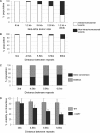Analysis of repair mechanism choice during homologous recombination
- PMID: 19553188
- PMCID: PMC2731894
- DOI: 10.1093/nar/gkp495
Analysis of repair mechanism choice during homologous recombination
Abstract
Double-strand breaks (DSBs) occur frequently during cell growth. Due to the presence of repeated sequences in the genome, repair of a single DSB can result in gene conversion, translocation, deletion or tandem duplication depending on the mechanism and the sequence chosen as partner for the recombinational repair. Here, we study how yeast cells repair a single, inducible DSB when there are several potential donors to choose from, in the same chromosome and elsewhere in the genome. We systematically investigate the parameters that affect the choice of mechanism, as well as its genetic regulation. Our results indicate that intrachromosomal homologous sequences are always preferred as donors for repair. We demonstrate the occurrence of a novel tri-partite repair product that combines ectopic gene conversion and deletion. In addition, we show that increasing the distance between two repeated sequences enhances the dependence on Rad51 for colony formation after DSB repair. This is due to a role of Rad51 in the recovery from the checkpoint signal induced by the DSB. We suggest a model for the competition between the different homologous recombination pathways. Our model explains how different repair mechanisms are able to compensate for each other during DSB repair.
Figures





References
Publication types
MeSH terms
Substances
LinkOut - more resources
Full Text Sources
Other Literature Sources
Molecular Biology Databases
Research Materials

